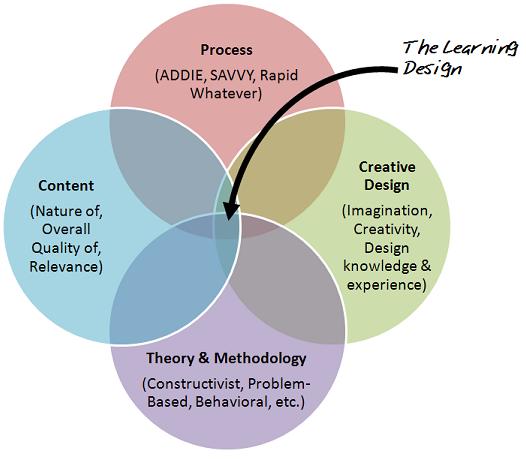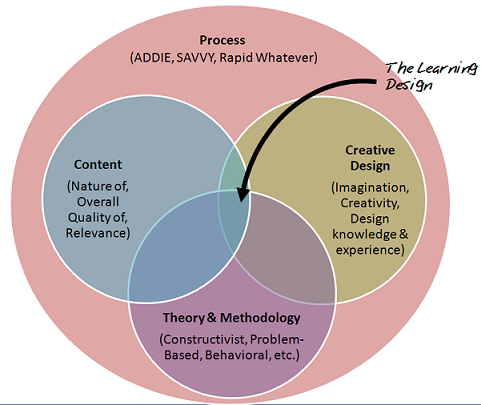So there was a twitter post from @edwsonoma pointing to this blog entry about tools. It contains this sentence:
Consider what we want to do, then determine which tools support you doing it better, farther, wider, faster.
This was significant to me, because it came in the middle of more posts about the relevance of ADDIE.
Both Ellen Wagner and Tom Gram make the point that ADDIE is a process (Ellen: “Let’s say it loudly and proudly – ADDIE isn’t a learning model. Nothing about it says “learning model”. It’s a process model.” Tom: “Adherents and crankites alike view ADDIE as an “instructional design” methodology when in fact it should be viewed more as a project management process for learning projects.“)
Yup — ADDIE is a tool, and as such, is fairly neutral. The issues and heat seem to come from the associations (which I already ranted about here), and the status in the field that it has of being the destination rather than the vehicle.
Which caused me to do a little visual playing (take these as visual brainstorming rather than well-developed models, please):
Should it be more like this?

Or maybe this?

Not sure, but I do know that there is frequently a imbalance in the emphasis that gets placed on the different areas, and an insufficient number of tools to help practioners with both the green and purple circles. And the learner needs a place in there somewhere, too.
Let’s face it — ADDIE (or any process) is the easy part to define — it has the least number of variables, is the most under our control, and is the easiest to understand and is the most visible.
Other things — how to be creative, how to best get people to really learn, how to best match content and experience to learners and outcomes — those are much harder to figure out, and much harder to know if you got right.
So what do you think? What’s missing/wrong in the diagrams?

In both diagrams the overlap area brings the same end result no matter if process encompasses all or not. I point that out because I think that your end point (focus on design solutions instead of tools) is precisely right but we tend to focus on the process component because it is the thing that we can easily, finitely sink our teeth into as designers.
As you said ADDIE or SAVVY or whatever are only tools and its easy to focus too much attention on the tool instead of the design thinking that should be applied to the problem. As a developing illustrator, I often found myself struggling with the conceptual process and would instead focus on the tool (what I need is a better paint brush) instead of thinking…really thinking about how to best solve the design problem.
We ID’s are no different.
Great post – you got me thinking.
Brilliant, brilliant, brilliant.
So much of the conversation in the training world seems devoted to ADDIE and deploying the latest whiz-bang social media elearning tool in any given learning environment. From my standpoint, that’s because those are things that we can control/manipulate/get attention for (just like Dan said above). They’ll win kudos from our peers in the training world but seem to be met with large rounds of indifference by the very clients we’re trying to serve.
We need to spend much more time in the Creative part of your diagram. That’ll force us to keep the learner, and the performance goals they need to hit, squarely at the center of everything we do; to focus less on us and more on them.
Replacing the term “Instructional Design” with “Results Design” might also help that process, but that’s a conversation for another time…
I think it’s not just about control. It’s also about capacity. For one reason or another many (I could say most in my experience, but I haven’t interacted with near as many IDs as their are in the wild) IDs simply don’t have the experience or capacity to utilize the tools that they already have available to them to synthesize an output that produces results.
It’s not about tools. It’s about people. Selecting the right people first. Then growing these people the right way. Most current academic programs are staffed with folks that aren’t accomplished performers. Hard to build Journeymen if you don’t add Masters to the mix.
The right kind of feedback will help to develop latent design skills, it will also weed out those that are simply incapable of it and direct the design disabled down the right professional path.
The problem isn’t tools. It’s our ignorance of the shortcomings of our system of development. It’s our inability to define what it is that we do. It’s our (at large) inability to develop the right skills and world-view. The problem is us.